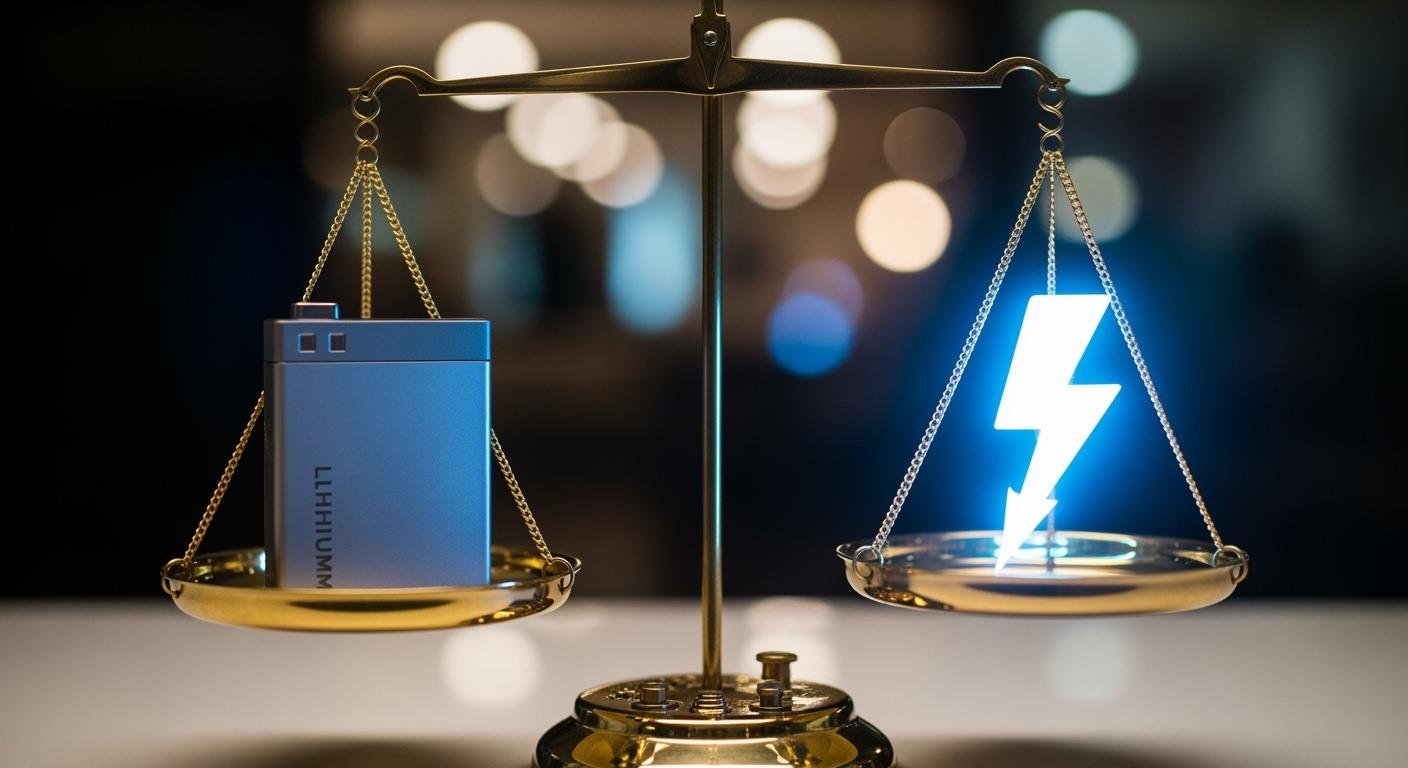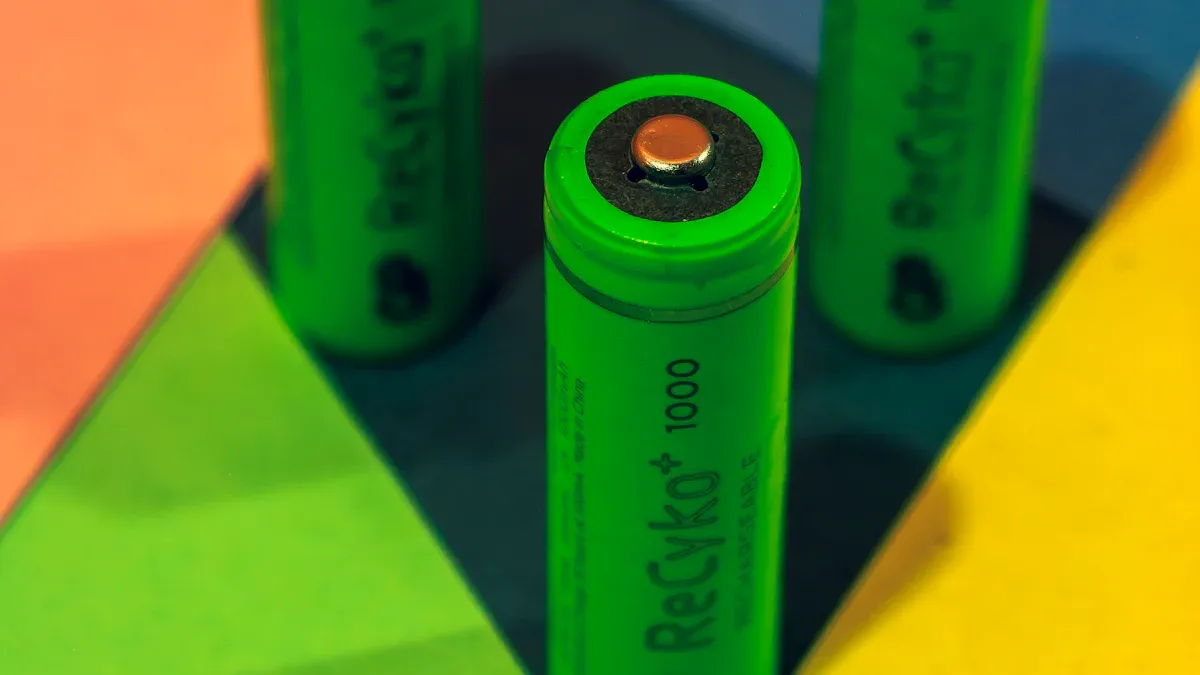
A lithium-ion battery’s final weight is a direct function of its total battery capacity and its specific energy density. The global market for lithium-ion batteries is expanding rapidly, with projections showing it could reach USD 578.20 billion by 2032. This growth makes understanding battery weight and density crucial for any project. A simple formula provides a powerful tool for estimating the lithium battery weight.
The Core Formula 📝
Battery Weight (kg) = Total Energy (Wh) / Specific Energy (Wh/kg)
This guide breaks down each part of the equation. It makes calculating the lithium-ion battery weight a straightforward task.
How Much Does a Lithium Battery Weight?

Estimating the final lithium battery weight is a manageable process. The answer to “how much does a lithium battery weight?” involves a three-step measurement method for lithium battery weight. A user first determines the total energy needed. Next, they find the specific energy of their chosen battery chemistry. Finally, they calculate the final weight.
Determine Required Capacity (Wh)
The first step is to calculate the total energy your device needs. This is the battery capacity, measured in Watt-hours (Wh). The formula is simple and effective.
Capacity Formula 🧮
Capacity (Wh) = Device Power (Watts) × Desired Runtime (Hours)
A device’s power consumption is its operating wattage. People can usually find this information on the device’s label or in its manual. The desired runtime is how long you need the device to operate between charges. For example, a longer e-bike ride requires a battery with more amp-hours and, therefore, a higher Wh rating. A 48V, 21Ah battery provides 1008Wh, enabling rides of 50 to 80 miles.
Common devices have varied power needs:
- Laptops and ultrabooks consume between 45W and 100W.
- Drones typically use 5W to 60W while charging.
- Portable coolers or mini-fridges operate around 50W to 90W.
Let’s look at some portable refrigerator power needs.
| Refrigerator Type | Running Watts (Watts) |
|---|---|
| Mini Fridge | 60–180 |
| Compact/RV Fridge | 36–60 |
If a user needs to power a 60-watt mini-fridge for 8 hours, the required battery capacity is 60W × 8h = 480Wh. This value is the foundation for your battery weight calculation.
Find the Specific Energy (Wh/kg)
Next, a user must consider the battery chemistry. Different lithium-ion chemistries pack energy differently. This characteristic is called specific energy, or gravimetric energy density. It measures how much energy a battery stores per unit of mass, typically in Watt-hours per kilogram (Wh/kg). A higher energy density means a lighter battery for the same capacity. The choice of chemistry directly impacts the final lithium-ion battery weight.
Lithium-ion batteries come in several common types. Each type offers a different balance between energy density, cost, and lifespan.
Quick Tip 💡 A higher specific energy (Wh/kg) value results in a lower overall battery weight for the same amount of energy.
Here is a comparison of common lithium-ion chemistries and their typical specific energy ranges.
| Chimie des batteries | Specific Energy (Wh/kg) | Key Feature |
|---|---|---|
| Phosphate de fer lithié (LFP) | 90–160 | Longevity and safety |
| Lithium Nickel Manganèse Cobalt (NMC) | 150–250 | Balanced performance |
| Lithium Nickel Cobalt Aluminum (NCA) | 200–260 | High energy density |
| Oxyde de lithium et de cobalt (LCO) | 150-200 | Popular in consumer electronics |
NMC and NCA chemistries offer a higher energy density, making them ideal for applications where weight is a primary concern. LFP offers a lower density but excels in safety and cycle life, making it a great choice for stationary storage. Understanding this trade-off between battery weight and density is crucial.
Calculate the Final Weight
The final step combines the required energy and the specific energy to find the battery’s weight. This is where the core formula comes into play. This measurement method for lithium battery weight provides a close estimate.
Battery Weight (kg) = Total Energy (Wh) / Specific Energy (Wh/kg)
Let’s continue with our 480Wh example. Suppose a user chooses an LFP battery for its safety and longevity. We can use an average specific energy for LFP, such as 110 Wh/kg.
- Calculation:
480 Wh / 110 Wh/kg = 4.36 kg
This calculation gives the weight of the lithium-ion cells alone. The final battery pack includes other components that add to the total weight.
Important Note: Add a Buffer ⚖️ Always add 15-25% to your calculated weight. This buffer accounts for the battery’s non-cell components, including:
- The protective casing
- Internal wiring and connectors
- The Battery Management System (BMS)
Applying a 20% buffer to our example:
- Buffer Weight:
4.36 kg × 0.20 = 0.87 kg - Estimated Final Weight:
4.36 kg + 0.87 kg = 5.23 kg
This final figure gives a much more realistic estimate of the lithium battery weight. This process answers the question “how much does a lithium battery weight?” with practical accuracy, helping users plan their projects effectively by balancing battery weight and density.
Factors That Define Lithium-Ion Battery Weight

Several key factors determine the final lithium-ion battery weight. Understanding the relationship between battery weight and density helps users make informed choices. The chemistry, total energy needs, and construction of the battery pack all play a significant role in its final mass.
Chimie des batteries
The choice of battery chemistry is the most significant factor influencing weight. Different lithium-ion chemistries have different energy density ratings. A higher energy density means more energy can be stored in less weight.
The formula
Battery Weight (kg) = Battery Capacity (Ah) × Nominal Voltage (V) / Energy Density (Wh/kg)shows that for the same total energy, a battery with a lower energy density will have a greater weight.
For example, lithium-ion batteries like NMC and NCA offer high energy density, making them lighter. LFP chemistry has a lower density, resulting in a heavier battery for the same power.
| Chimie des batteries | Densité énergétique (Wh/kg) |
|---|---|
| LFP (Lithium Iron Phosphate) | 90-120 |
| NCM (Nickel Manganese Cobalt) | 150-250 |
| NCA (Nickel Cobalt Aluminum) | 200-260 |
However, weight is not the only consideration. A heavier LFP battery offers significant advantages in safety and lifespan.
- Sécurité: LFP lithium-ion batteries are more thermally stable and far less likely to experience thermal runaway than NMC types.
- Longevity: An LFP battery can often endure 3,000 to 6,000 charge cycles, while an NMC battery typically provides 1,000 to 2,000 cycles.
Capacité et tension
A battery’s total energy, or battery capacity, is measured in Watt-hours (Wh). A higher Wh rating always results in a heavier battery, as more active material is needed to store the energy. This capacity is a product of its Amp-hours (Ah) and Voltage (V).
The formula is Watt-hours = Amp-hours × Voltage.
This means two lithium-ion batteries with the same Ah rating can have very different energy capacities and weights.
- A 100Ah, 12V battery = 1,200 Wh
- A 100Ah, 48V battery = 4,800 Wh
The 48V battery stores four times the energy and will be significantly heavier. For a fixed energy need, using a higher voltage system can reduce the required Amp-hours, which helps manage the overall lithium battery weight.
Cell vs. Pack Weight
The calculated lithium battery weight often refers only to the individual lithium-ion cells. A complete battery pack, however, includes many other components that add considerable weight. This is why a 15-25% buffer is essential for a realistic estimate.
A finished battery pack contains more than just cells. These additional parts protect the battery and ensure it functions correctly.
- Système de gestion de la batterie (BMS): A circuit board that monitors and protects the cells.
- Housing: A protective case made of plastic or metal.
- Cooling System: Components like heat sinks or liquid cooling plates that manage temperature.
- Wiring and Connectors: Busbars and wires that connect all the components.
These elements are crucial for safety and performance but contribute to the final lithium-ion battery weight.
Choosing the Right Lithium Battery Weight for Your Needs
Selecting the right battery involves balancing capacity, performance, and weight. The ideal choice depends entirely on the application’s primary goal. Understanding the trade-offs between densité énergétique and chemistry helps users find the perfect battery.
Portability Focus
For devices like drones, cameraset smartphones, low weight is the top priority. Users need lightweight lithium batteries that provide enough power without making the device heavy or bulky.
Key Insight ✈️ In portable electronics, a higher energy density is crucial. It allows a battery to be both powerful and lightweight.
Lithium Polymère (LiPo) and Lithium Cobalt Oxide (LCO) are excellent choices for these applications. These lithium-ion chemistries offer a high energy density, packing significant energy into a small, lightweight package. This makes lightweight lithium batteries essential for products where mobility is key. The final weight of the battery directly impacts the device’s usability. A lightweight battery ensures longer flight times for a drone and easier handling for a camera. These lightweight lithium batteries are designed for maximum portability.
Stationary and Longevity Focus
When a battery does not need to be moved, the focus shifts from weight to lifespan and safety. For applications like home energy storage, a heavier battery is perfectly acceptable. The lithium battery weight is a secondary concern.
Lithium Iron Phosphate (LFP) is the leading chemistry in this category. Although LFP has a lower energy density and a higher weight than other lithium-ion types, it offers major advantages:
- Exceptional Safety: LFP is very stable and has a low risk of thermal runaway.
- Long Cycle Life: An LFP battery can endure over 6,000 charge cycles, far more than NMC or LCO lithium-ion batteries.
These benefits make the extra weight a smart trade-off for a stationary battery that needs to last for many years. The lower density is less important than reliability.
High-Performance Focus
High-performance applications like racing drones et outils électriques demand rapid power delivery. The battery must provide strong bursts of energy. The weight implications are critical, as a lightweight battery enhances agility.
For these needs, high-discharge lithium-ion batteries are required. LiPo batteries using NMC chemistry are a popular choice. These lightweight lithium batteries offer an excellent balance of high energy density and the ability to discharge power very quickly. This characteristic is measured by the C-rating. A higher C-rating means the battery can deliver more power instantly. This makes these lightweight lithium batteries perfect for tasks that need maximum power in a lightweight form.
Choosing the right lithium-ion battery involves a key trade-off. The final lithium battery weight depends on the required battery capacity and the chosen chemistry’s energy density. Understanding battery weight and density is simple. The formula Weight = Energy / Specific Energy gives users a powerful tool for estimating the lithium-ion battery weight. Every lithium-ion chemistry has its own balance of weight and performance.
Final Check ✅ For the most accurate calculation, users must always check the manufacturer’s specification sheet. This document provides the precise “Specific Energy (Wh/kg)” value for the specific lithium-ion battery.
FAQ
Why is battery chemistry important for weight?
Different lithium-ion chemistries have different energy densities. A high-density battery chemistry packs more power into less mass. This makes the overall battery lighter. A lower-density lithium-ion battery will be heavier for the same energy capacity. The right battery depends on project needs.
Does a higher voltage make a battery heavier?
Not directly. A higher voltage battery can be more efficient. For a specific energy need (Wh), a higher voltage system requires fewer Amp-hours. This can lead to a lighter overall battery pack. The total energy stored in the battery is the main factor for weight.
What is the difference between cell weight and pack weight?
Cell weight is only the mass of the individual lithium-ion cells. The final battery pack weight is always higher. It includes the protective case, wiring, and the Battery Management System (BMS). A user must add a buffer for a realistic estimate of the total battery weight.
How does a user calculate the total energy of a battery?
A user calculates a battery’s total energy in Watt-hours (Wh). They multiply the battery’s Amp-hour (Ah) rating by its nominal Voltage (V).
Energy (Wh) = Amp-hours (Ah) × Voltage (V)
This value is essential for estimating the final lithium-ion battery weight.

